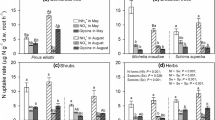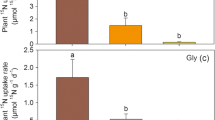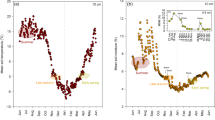Abstract
Background and aims
Plants differ in their ability to use different nitrogen (N) chemical forms, these differences can be related to their ecology and drive community structure. The capacity to uptake intact organic N has been observed in plants of several ecosystems. However, soil organic N uptake by Mediterranean plants is unknown despite organic N being abundant in Mediterranean ecosystems. We compare the uptake of different N forms in two widespread coexisting Mediterranean forest trees with contrasting ecophysiological characteristics: Quercus ilex and Pinus halepensis.
Methods
To estimate root uptake rate of each N form we used equimolar solutions (1 mM N) of 15NO3 −, 15NH4 + and 15N-13C glycine.
Results
NH4 + and glycine were taken up at a similar rate, but faster than NO3 − in both species. Intact dual labeled glycine was found in both species, demonstrating that both species can absorb intact organic N.
Conclusions
Despite their ecological differences, both species had similar preference for N forms suggesting no fundamental niche complementarity for N uptake. The higher preference for NH4 + and glycine over NO3 − possibly reflects adaptation to the differing proportions of N forms in Mediterranean soils.


Similar content being viewed by others
References
Aidar MPM, Schmidt S, Moss G et al (2003) Nitrogen use strategies of neotropical rainforest trees in threatened Atlantic Forest. Plant Cell Environ 26:389–399
Ashton IW, Miller AE, Bowman WD, Suding KN (2010) Niche complementarity due to plasticity in resource use: plant partitioning of chemical N forms. Ecology 91:3252–3260
Baquedano FJ, Castillo FJ (2006) Comparative ecophysiological effects of drought on seedling of the Mediterranean water-saver Pinus halepensis and water-spenders Quercus coccifera and Quercus ilex. Trees 20:689–700
Bonilla D, Rodá F (1992) Soil nitrogen dynamics in a holm oak forest. Vegetatio 99:247–257
Boudsocq S, Niboyet A, Lata JC et al (2012) Plant preference for ammonium versus nitrate: a neglected determinant of ecosystem functioning? Am Nat 180:60–69
Chalot M, Brun A (1998) Physiology of organic nitrogen acquisition by ectomycorrhizal fungi and ectomycorrhizas. FEMS Microbiol Rev 22:21–44
Cruz C, Lips SH, Martins-Loução MA (1993) Interactions between nitrate and ammonium during uptake by carob seedlings and the effect of the form of earlier nitrogen nutrition. Physiol Plant 89:544–551
Delgado-Baquerizo M, Covelo F, Gallardo A (2011) Dissolved organic nitrogen in Mediterranean ecosystems. Pedosphere 21:309–318
Dias T, Clemente A, Martins-Loução MA et al (2014) Ammonium as a driving force of plant diversity and ecosystem functioning: observations based on 5 years´ manipulation of N dose and form in a Mediterranean ecosystem. PLoS One 9:e92517
Houlton BZ, Sigman DM, Schuur EAG, Hedin LO (2007) A climate-driven switch in plant nitrogen acquisition within tropical forest communities. PNAS 104:8902–8906
Kahmen A, Renker C, Unsicker SB, Buchmann N (2006) Niche complementarity for nitrogen: an explanation for the biodiversity and ecosystem functioning relationship. Ecology 87:1244–1255
Kielland K (1994) Amino acid absorption by arctic plants: implications for plant nutrition and nitrogen cycling. Ecology 75:2373–2383
Kielland K, McFarland J, Olson K (2006) Amino acid uptake in deciduous and coniferous taiga ecosystems. Plant Soil 288:297–307
Kronzucker HJ, Siddiqi MY, Glass ADM (1997) Conifer root discrimination against soil nitrate and the ecology of forest succession. Nature 385:59–61
Kronzucker HJ, Siddiqi MY, Glass ADM, Britto DT (2003) Root ammonium transport efficiency as a determinant in forest colonization patterns: an hypothesis. Physiol Plant 117:164–170
LeBauer DS, Treseder KK (2008) Nitrogen limitation of net primary productivity in terrestrial ecosystems is globally distributed. Ecology 89:371–379
Li X, Rennenberg H, Simon J (2015) Competition for nitrogen between Fagus sylvatica and Acer pseudoplatanus seedlings depends on soil nitrogen availability. Front Plant Sci 6:1–11
McKane RB, Johnson LC, Shaver GR et al (2002) Resource-based niches provide a basis for plant species diversity and dominance in arctic tundra. Nature 415:68–71
Metcalfe RJ, Nault J, Hawkins BJ (2011) Adaptations to nitrogen form: comparing inorganic nitrogen and amino acid availability and uptake by four temperate forest plants. Can J For Res 1637:1626–1637
Miller AE, Bowman WD (2003) Alpine plants show species-level differences in the uptake of organic and inorganic nitrogen. Plant Soil 250(2):283–292
Nasholm T, Persson J (2001) Plant acquisition of organic nitrogen in boreal forests. Physiol Plant 111:419–426
Näsholm T, Ekblad A, Nordin A et al (1998) Boreal forest plants take up organic nitrogen. Nature 392:914–916
Näsholm T, Huss-Danell K, Högberg P, Hogberg P (2000) Uptake of organic nitrogen in the field by four agriculturally important plant species. Ecology 81:1155–1161
Osone Y, Tateno M (2005) Nitrogen absorption by roots as a cause of interspecific variations in leaf nitrogen concentration and photosynthetic capacity. Funct Ecol 19:460–470
Pemán J, Navarro RM, Nicolás JL, et al. (2014) Producción y manejo de semillas y plantas forestales. OAPN. Ministerio de Agricultura, Alimentación y Medio Ambiente. Madrid
Persson J, Näsholm T (2001) A GC-MS method for determination of amino acid uptake by plants. Physiol Plant 113:352–358
Persson J, Högberg P, Ekblad A et al (2003) Nitrogen acquisition from inorganic and organic sources by boreal forest plants in the field. Oecologia 137:252–257
Sánchez-Gómez D, Valladares F, Zavala MA (2006) Performance of seedlings of Mediterranean woody species under experimental gradients of irradiance and water availability: trade-offs and evidence for niche differentiation. New Phytol 170:795–806
Sardans J, Rodà F, Peñuelas J (2006) Effects of a nutrient pulse supply on nutrient status of the Mediterranean trees Quercus ilex subsp. ballota and Pinus halepensis on different soils and under different competitive pressure. Trees 20:619–632
Schulz H, Härtling S, Stange CF (2011) Species-specific differences in nitrogen uptake and utilization by six European tree species. J Plant Nutr Soil Sci 174:28–37
Sharp Z (2005) Principles of Stable Isotope Geochemistry. Pearson/Prentice Hall, 2007
Sokal RR, Rohlf FJ (2012) Biometry: the principles and practice of statistics in biological research, 4th edn. W. H. Freeman, New York
Song M, Zheng L, Suding KN et al (2015) Plasticity in nitrogen form uptake and preference in response to long-term nitrogen fertilization. Plant Soil 394:215–224
Svennerstam H, Jämtgård S, Ahmad I et al (2011) Transporters in Arabidopsis roots mediating uptake of amino acids at naturally occurring concentrations. New Phytol 191:459–467
Uscola M, Oliet JA, Villar-Salvador P et al (2014a) Nitrogen form and concentration interactively affect the performance of two ecologically distinct Mediterranean forest trees. Eur J For Res 133:235–246
Uscola M, Villar-Salvador P, Oliet J, Warren CR (2014b) Foliar absorption and root translocation of nitrogen from different chemical forms in seedlings of two Mediterranean trees. Environ Exp Bot 104:34–43
Uscola M, Villar-Salvador P, Gross P, Maillard P (2015) Fast growth involves high dependence on stored resources in seedlings of Mediterranean evergreen trees. Ann Bot 115:1001–1013
Warren CR (2006) Potential organic and inorganic N uptake by six eucalyptus species. Funct Plant Biol 33:653
Warren CR (2012) Post-uptake metabolism affects quantification of amino acid uptake. New Phytol 193:522–531
Warren CR, Adams MA (2002) Possible causes of slow growth of nitrate-supplied Pinus pinaster. Can J For Res 32:569–580
Zavala MA, Espelta JM, Retana J (2000) Constraints and trade-offs in Mediterranean plant communities: the case of holm oak-Aleppo pine forests. Bot Rev 66:119–149
Acknowledgments
We are grateful to C.N. R.G. F. “El Serranillo” (MAGRAMA) for cultivating the plants. This study was supported by a FPU-MEC grant to MU, and by projects AGL2006-12609-C02-01/FOR (ENCINUT), AGL2011-24296 ECOLPIN (MICIIN), CGL2014-53308-P SERAVI (MINECO) and Remedinal 3 (S2013/MAE-2719, CAM). CW was supported by a Future Fellowship from the Australian Research Council (FT100100024).
Author information
Authors and Affiliations
Corresponding author
Additional information
Responsible Editor: Ad C. Borstlap.
Electronic supplementary material
ESM 1
(DOCX 38 kb)
Figure S1
a) Image showing the root growth of one year-old seedlings, in container-grown plants the plug is a mass build up with the roots that hold the substrate. In the seedlings used in the experiment a plug was formed the first year when cultivated in 0.3 L containers. When the seedling were transplanted to a larger pot (2.5 L pots) for the labeling experiment new fine roots protruded out of the plug and colonized the transplanting substrate. b) Picture of seedling at harvesting, the plug is delimited by the blue lines. (JPEG 39 kb)
Rights and permissions
About this article
Cite this article
Uscola, M., Villar-Salvador, P., Oliet, J. et al. Root uptake of inorganic and organic N chemical forms in two coexisting Mediterranean forest trees. Plant Soil 415, 387–392 (2017). https://doi.org/10.1007/s11104-017-3172-6
Received:
Accepted:
Published:
Issue Date:
DOI: https://doi.org/10.1007/s11104-017-3172-6




